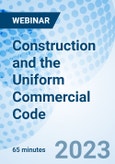Understand how and when the law of sales affects the rights and responsibilities of the parties in a construction project.
Construction contracts are service contracts and sales of personal property contracts are contracts governed by Article 2 of the Uniform Commercial Code. What are the theoretical and practical differences between the two types of contracts? When is the sale of goods simply part of a construction contract, and when does a construction contract become a contract for the sale of goods? How does a general contractor make sure that the personal property components it purchases meet the warranty requirements of the owner? How does the general contractor make sure that its purchase orders with sellers of personal property comply with the requirements of his contract with the owner? How does the seller of personal property protect itself from disproportionate liability? This information will provide answers to these important questions.Learning Objectives
- You will be able to discuss where the sale of personal property intersects and diverges.
- You will be able to review the owner’s perspective, the general contractor’s perspective, the subcontractor’s perspective, and the supplier’s perspective.
- You will be able to describe insurance and performance bonds.
- You will be able to explain how rights and obligations are known and enforced.
Agenda
Where Do Construction and Contracts for the Sale of Personal Property Intersect and Diverge?
How Do Parties Typically Enter Into Construction Contracts?
How Do Parties Typically Enter Into Contracts for Sale or Purchase of Goods?
The Owner’s Perspective
The General Contractor’s Perspective
The Subcontractor’s Perspective
The Supplier’s Perspective
Insurance and Performance Bonds
Architects and Design Professionals
Speakers

Conor Shankman,
Bernstein, Shur, Sawyer & Nelson, P.A.- Shareholder of Bernstein, Shur, Sawyer & Nelson, P.A.
- Experience, focusing on commercial litigation across numerous industries
- Counsels industries on litigating commercial and residential real estate disputes; helping to solve data, privacy, and technology integration disputes.
- Received various awards including the President’s Instructional Technology Fellowship at Harvard Law School
- J.D. degree, University of Maine School of Law; Ed.M. degree, Harvard University Graduate School of Education; B.A. degree, Vassar College

George F. Burns, Esq.,
Bernstein, Shur, Sawyer & Nelson, P.A.- Shareholder of Bernstein, Shur, Sawyer & Nelson, P.A. and member of the firm's Construction and Litigation Practice Groups, and its Dispute Resolution Group
- Over four decades of experience, focusing on litigating, arbitrating, and mediating business and construction disputes
- Trial experience ranges from securities claims and partnership disputes, to construction cases involving schools, power plants, and bridges
- Well-versed in assisting clients in the forest products industry and represents a number of related trade associations
- Member of the Commercial Panel of the American Arbitration Association
- Appointed by the Maine Supreme Court as an arbitrator, mediator, and early neutral evaluator for its Court Alternative Dispute Service (CADRES)
- Frequently shares his expertise in construction law, as well as related areas like insurance and product liability, in lectures and seminars around the country
- Co-author with his partner Michael Bosse of the ABA book, Building the Construction Case: A Blueprint for Litigators, 2014
- J.D. degree, New York University; B.S. degree in international affairs, Georgetown University School of Foreign Service
- Can be contacted at gburns@bernsteinshur.com
Who Should Attend
This live webinar is designed for project managers, engineers, construction managers, contractors, subcontractors, presidents, vice presidents, project engineers, construction professionals, architects, and attorneys.










